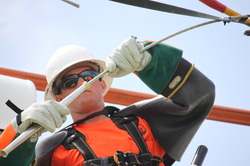
The revised OSHA standards that our electric utilities follow are nothing new as they have been in place for over a year now. With all revisions come questions and clarification. Many of you are in different stages of compliance when it comes to supplying employees with clothing for protection from electric arcs and flames. It has been an ongoing struggle to make the so called ”right decision” when purchasing this expensive equipment. Last week, the Iowa Dept. of Labor helped some of you decide what type of garment is required to be worn to protect line workers while wearing rubber protective sleeves.
The Iowa Association of Electric Cooperatives (IAEC) petitioned I-OSHA in May regarding the proper use of protective clothing under rubber protective sleeves. The IAEC requested clarification on whether their employees can meet the current protective clothing standards while wearing short sleeve shirts under rubber protective sleeves instead of long sleeve shirts. Other parties included in this request were Alliant Energy, MidAmerican Energy, and the International Brotherhood of Electrical Workers. On July 13th, 2015 representatives from 3 of these groups met with the Dept. of Labor to discuss the issue.
One of the main focal points of this issue was heat stress concerns during the summer months in Iowa. Temperatures during the summer can reach the 100 degree mark and the rubber protective gear that line workers must wear during work makes it feel even hotter. Many of these workers try to do their best during these times by choosing lighter clothing for the summer months. Unfortunately, they cannot wear some of the space aged clothing that keeps many of us cool during the summer due to its flammability and the possibility of it melting during an arc flash or fire. Allowing short sleeved shirts to be worn underneath rubber sleeves is a policy used by many in order to address heat stress. It has been noted that many utilities in our sometimes extremely warm southern states allow their workers to work without rubber sleeves when at all possible. One person was quoted, “We’re in tropical weather down here. Of course we don’t wear sleeves except in those situations where we have to. We would have guys dropping like flies in this heat if we wore them all of the time.” Heat stress was not the only issue discussed during the meeting.
The cost of supplying workers with tools, equipment, and now clothing is very expensive. Fire retardant and arc rated clothing is considered personal protective clothing and it is the employer’s responsibility to purchase these items for their employees. It was discussed that the cost of long sleeve shirts can be $50 higher than a short sleeve shirt of equal quality and protection. The cost of clothing can amount to at least $2000 per employee and I have even heard of costs in the $3500 range. Budgets are always a major concern, but worker safety has to take precedence, as was the opinion from one of the involved parties along with I-OSHA’s view on the matter.
Officials from OSHA cited current standards that require workers exposed to electric arc hazards be protected from those hazards with arc rated clothing that covers the entire body. Rubber protective sleeves are not considered arc rated and therefore, do not meet this requirement. I-OSHA does realize heat stress and costs are important issues that we must deal with, but their job is to help workers return home after their workday is complete. A declaratory order was issued to all parties on Aug, 10th stating that workers must wear long sleeved, arc rated/FR shirts under rubber protective sleeves whenever they are worn during live line work. At this time, Iowa has been the only state that has taken this position. This doesn’t mean that other states won’t, but there may also be pressure on equipment manufacturers to provide a better product that has an arc rating. Clothing manufacturers are already working on clothing that protects the worker and also provides the comfort that they desire. No one can dispute that clothing systems have come a long way in the last few years.
Whatever your utility decides to do in regards to protective clothing, make sure that those decisions are made in order to provide a safe workplace and not just to meet a mandate or price point. Equipment fails, employees make errors, and when these things occur they can lead to a serious injury or fatality without the proper protection in place. Responsibility also falls onto employees that you supply clothing for. No matter what the reasons or excuses are for not wearing it, they aren’t as important as returning home in one piece after the work day is done. It won’t protect you if it’s not worn and worn properly. We will keep you posted with any more developments as they arise.

 RSS Feed
RSS Feed
